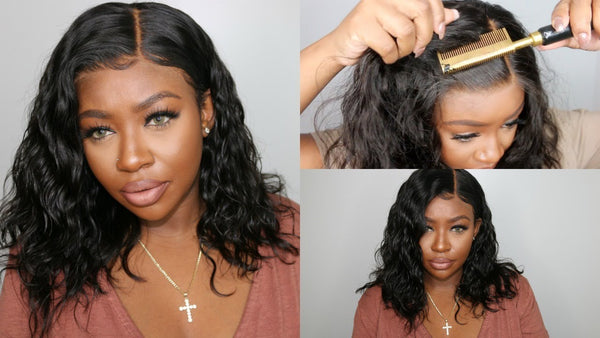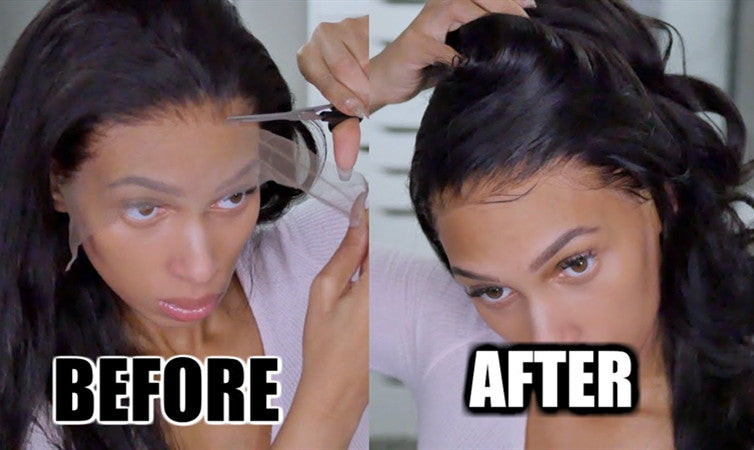Lace front wig, without a doubt, are among the trendiest wigs currently available. They look natural are also easy to style, comfortable to wear, among many other advantages. However, if installed incorrectly, this particular wig typically causes discomfort and even causing damage to your hairline.
This blog will explain some of the dos and don’ts, particularly when it comes to the hairline and natural hair protection. Without further ado, let’s get to it.
Do Lace Wigs Damage Your Natural Hair?
For starters, let’s talk about whether the lace wig can damage your hairline. It’s a known fact that human hair wigs, particularly lace wigs, are made using high-quality real hair. Human hair lace wigs neither damages your hairline nor natural hair.
On the contrary, what damages your natural hair is usually an improper lacing system installation and poor removal methods.
When installing your lace hairpiece using adhesive, make sure that you use it moderately and in regions specifically designed for attaching the lace front wig. On the other hand, before wearing your wig, ensure that your hair is dry, then proceed to wear a breathable cap that generally protects your natural hair.
Following the right wig installation procedure is not only ideal for protecting your natural hair, but it’s also convenient for securing your wig.
Factors that lead to hair edge damage
1. Wearing a wig that doesn’t fit
A wig that usually fits tightly will lead to hair breakage, loss, and edge damage. It’s therefore advisable to let a professional measure your wig if you want a perfectly fitting wig.
2. Avoiding wash day
As much as it might be tempting to skip wash day, never do so. Lack of shampooing and conditioning leads to accumulating bacteria and dirt on your hair and scalp, leading to edge damage.
3. Poor hairline maintenance
Stocking caps play the role of protecting your natural hair underneath while also making it appear as flat as possible and appear less bulky. However, they are also the main cause of dryness and hair breakage along the hairline.
To prevent edge damage, all you have to do is invest in a high-quality wig cap, then slide the stocking cap behind your ear to exposed your hairline.
4. Wig adhesives
Adhesive application is one of the factors that contribute to edge damage. In case your hairstyle is adhesive based, try to minimize how often you use the adhesive to prevent breakage or hair loss along your hairline.
5. Products that cause scalp irritation
Ladies who happen to have a sensitive scalp should stay away from synthetic wigs. The wigs sensitive material usually tends to cause burning, itching, scalp tenderness, leading to edge damage in the long run.

How to protect my Hairline When Wearing a lace Wig
- Choosing wig materials that cause less allergic reactions or irritations.
For instance, when you have a sensitive scalp, avoid wigs made from fillers having synthetic or animal hair.
- Secure your natural hair
Another way to protect your hairline is through braiding longer lengths on your natural hair to create a flat hair surface. Alternatively, if you happen to have short hair, then you can wrap it up. Always ensure that all your natural hair is properly secured before you apply any adhesive.
- Be careful not to apply glue on your natural hair.
If you must use adhesives, ensure that you apply it below your hairline. On the other hand, you can also protect your hairline using a wig cap and then apply a lace front glue gel or freeze spray to act as an adhesive.
- Wearing a wig behind the hairline
To install your hd lace wig perfectly, you can attach elastic straps or mini bobby pins inside the cap near your temple to hold your lace wig accordingly.
- Nurturing your natural hair.
Extra attention is always needed on the hair underneath your wig. Therefore, it’s essential to nurture your natural hair using scalp cleaner drops on the wig base to help reduce scalp build up or irritation between washes. In case you happen to have broken skin, avoid using scalp cleaning drops, particularly on the broken skin region, and when cleaning, be gentle.
- Be gentle when removing your wig.
When taking off a lace wig, be gentle and patient. First and foremost, use an adhesive remover. Apply sufficient amounts to soften the glue, and then proceed by slowly taking off the wig. In case you feel any resistance while doing so, add the remover and then wait for a few minutes before you try again.
- Never pull off your wig quickly.
When removing your wig, ensure that you pull it off slowly. Pulling off your wig quickly often leads to hair loss, wound, or even scalp irritation. Wig removal is, therefore, a delicate process that compares to waxing your head.
- Apply hair treatment on natural hair
After wig removal, thoroughly clean and condition your natural hair using hair products that are sulfur-free. For starters, you can apply a leave-in conditioner to prepare your hair before a wig installation, 2 to 3 weeks prior.
Besides the lace front wig enhancing your look, it’s usually recommendable to avoid over-wearing them and give your scalp a breather. Giving your natural hair tress all the care and attention it deserves is fundamental, especially if you want to have healthy hair while also maintaining your hairline.
- Wearing a glue less wig
Another great way of protecting your hairline when wearing wigs is by wearing glue less wigs. There are currently numerous lace front wigs that are glue less. Some come equipped with adjustable straps having combs that are effective for securing your wig. The straps or elastic bands enable the lace caps to stretch widely hence perfectly accommodating your head, thereby securing your wig.
Benefits of wearing a lace front glue less wig
- Glue less lace front wigs have an easy installation procedure and consume less time.
- Despite having an easy applying method, the overall outcome usually mimics real hair giving you a natural and realistic look.
- Glue less lace front wigs are user-friendly since they’re easy to install and remove, making them safe to wear, thereby not ruining your natural hair or hairline.
- They are less messy when being removed, unlike their counterparts that use adhesives. Therefore, the lace wig gives you the option of choosing either of the two hence offering convenience.
- The lace front glue-less wig is comfortable to wear, especially if you have sensitive skin, as there is usually no harmful glue in direct contact with your scalp.
- Another advantage of the lace front human hair wig that’s glue less is convenience. Taking off the wig can be done anywhere and anytime.
Conclusion
We hope this blog has been useful when it comes to solving the great old question, whether wearing the lace wig ruins your hairline. The lace wig human hair wig is currently among the top-selling wigs, thanks to the various installation methods that are user friendly, convenient, and quick to do.









